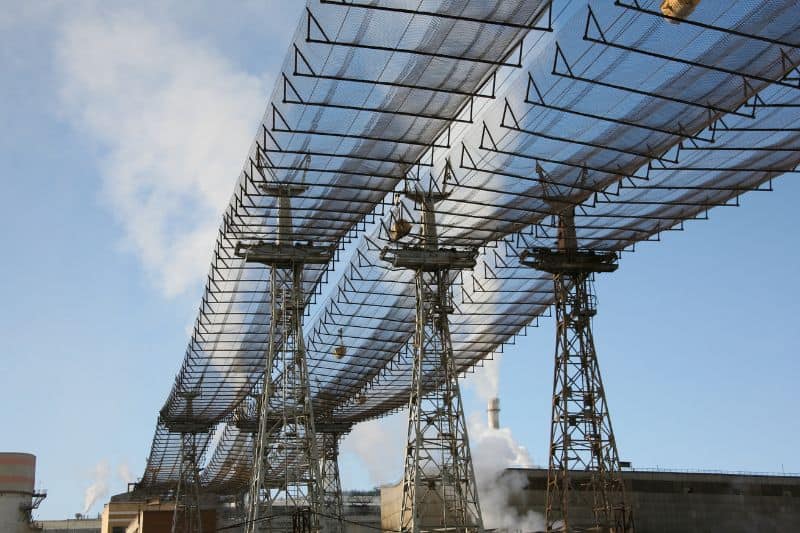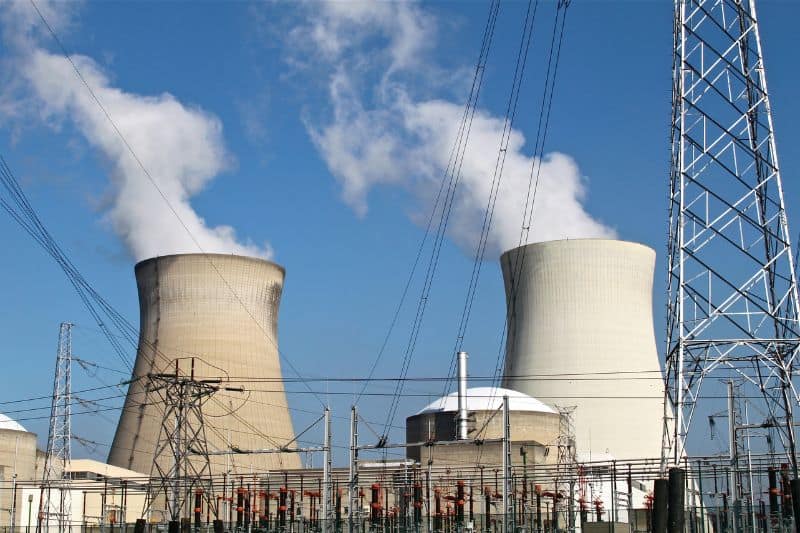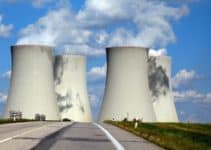When “nuclear energy” is mentioned, our minds usually gravitate towards thinking about nuclear bombs or the meltdowns that have happened at several nuclear plants worldwide.
Well, I’ve come to change that perspective of thinking!
Nuclear energy has a connection with bombs, but that’s not the only area it can serve!
Nuclear energy is the energy released by a chain of reaction, specifically by nuclear fission or fusion in the reactor.
The source of fuel used to generate nuclear energy is mined and processed uranium (enriched uranium), which is utilized to generate steam and produce electricity.
As of today, nuclear energy is considered one of the most environmentally friendly sources as it produces fewer greenhouse gas emissions during electricity production than traditional sources like coal power plants.
Nuclear fission is the process that is used in nuclear reactors to produce a high amount of energy using an element called uranium. It is the energy that is stored in the nucleus of an atom.
While being environmentally friendly is the big plus of this energy, disposal of radioactive waste and protecting people and the environment from its radiation is a big con of nuclear energy.
Therefore, expensive solutions are needed to protect mother earth from the devastating effects of nuclear energy.
In this article, we will explore the pros and cons of nuclear energy.
Pros of Nuclear Energy (Advantages)
By considering the advantages of nuclear energy, we can better appreciate the role nuclear energy can play in achieving sustainable and reliable energy in the future.
Let’s explore the benefits that make nuclear energy a compelling option for power generation.
1. Low Pollution
Nuclear power has a lot fewer greenhouse emissions. It has been determined that the number of greenhouse gases has decreased by almost half because of the prevalence of the utilization of nuclear power.
This avoids more than 470 million metric tons of carbon yearly, equivalent to removing 100 million cars off the road.
The thermal energy from nuclear reactors may also be used to decarbonize other energy-intensive sectors, such as transportation, the largest contributor to carbon pollution.
Nuclear energy has the least effect on nature since it doesn’t discharge gasses like methane and carbon dioxide, the primary “greenhouse gasses.”
There is no unfavorable impact on water, land, or any territories because of nuclear power, except when transportation is utilized.
Nuclear advocacy group the World Nuclear Association found that the average emissions from nuclear are 29 tonnes of CO2 per gigawatt-hour (GWh) of energy produced.
This compares favorably with renewable sources like solar (85 tonnes per GWh) and wind (26 tonnes per GWh) and even more favourably with fossil fuels like lignite (1,054 tonnes per GWh) and coal (888 tonnes per GWh).
2. High Power Output
The fuel-to-power output ratio for nuclear energy is incredibly high. It can meet the city and industrial needs with just one reactor, let alone multiple.
A relatively small amount of uranium can fuel a 1000 Megawatts electric plant, thus providing enough electricity to power a city of about half a million people.

Renewable sources, such as solar and wind, provide only enough power to meet residential or office needs.
They don’t yet have the capacity of nuclear to handle large-scale power needs, especially in the manufacturing world.
3. Stable Base Load Energy
Nuclear power plants provide a stable baseload of energy. Nuclear energy is widely used in America and makes up around 20% of all electricity generated in the United States.
This efficient energy source comes from the 98 nuclear power reactors dotted around 30 states in the US.
The stable production of power created by nuclear power plants means that it can ideally be used in conjunction with other forms of renewable energy.
For example, when the wind blows, nuclear plants can adjust energy output to be lower.
Conversely, when the wind is not blowing, and greater energy is needed, nuclear energy can be adjusted to compensate for the lack of wind (or solar) generated power.
4. Low Operating Costs
Nuclear power produces inexpensive electricity cheaper than gas, coal, or other fossil fuel plants. The cost of the uranium, utilized as a fuel in this process, is low, and it is needed very little to produce massive power.
Also, even though the expense of setting up nuclear power plants is moderately high, running them is pretty low.
It has been estimated that even factoring in costs such as managing radioactive fuel and disposal, nuclear plants cost between 33% to 50% of a coal plant and 20% to 25% of a gas combined-cycle plant.
The normal life of a nuclear reactor is anywhere from 40-60 years, depending on how often it is used and how it is being used. These variables, when consolidated, make the expense of delivering power low.
Even if the cost of uranium increases, the impact on the power cost will be much lower.
The US Department of Energy (DOE) estimates that replacing a 1GW nuclear power plant would require 2GW of coal or 3GW to 4GW from renewable sources to generate the same amount of electricity.
These will impact the power cost and make it much lower.
5. Reliability
It is estimated that with the current rate of uranium consumption, we have enough uranium for another 70-80 years.
A nuclear power plant, when producing energy, can run uninterrupted for even a year and more without interruptions or maintenance, making it a more reliable energy source.

As solar and wind energy depend on weather conditions, the nuclear power plant has no such constraints and can run without disruption in any climatic condition.
The consistent criticism of renewable energies, e.g., wind and solar energy, is that they only produce power when the wind blows, or the sun shines.
There are sure monetary focal points in setting up nuclear power plants and utilizing nuclear energy instead of traditional energy. It is one of the significant sources of power throughout the country.
The best part is that this energy has a persistent supply. It is broadly accessible, there is a lot in storage, and the supply is believed to last much longer than that of fossil fuels used in the same capacity.
6. More Proficient Than Fossil Fuels
The other primary point of interest in utilizing nuclear energy is that it is more compelling and proficient than other energy sources.
Several nuclear energy innovations have made it a much more feasible choice than others. They have high energy density as compared to fossil fuels.
The fuel required by the nuclear power plant is comparatively less than what is required by other power plants, as the energy released by nuclear fission is approximately 10 million times greater than the amount of energy released by fossil fuel atoms.
7. It Doesn’t Rely on Fossil Fuels
This is one of the reasons that numerous nations are putting a lot of time and money into nuclear power.
So what’s nuclear power’s greatest benefit, above any other advantages, that we may explore?
It doesn’t rely on fossil fuels and isn’t influenced by fluctuating oil and gas costs!
Coal and natural gas power plants discharge carbon dioxide into the air, which causes several environmental issues. With nuclear power plants, carbon emissions are insignificant.
8. Renewable?
Nuclear energy is not a renewable resource. Uranium, the nuclear fuel used to produce nuclear energy, is limited and cannot be produced repeatedly on demand.
However, uranium reserves are estimated to last another 80 years, whereas fossil fuels have a much more limited lifespan.
Since the Industrial Revolution, humans have been consistently and constantly depleting our fossil fuel reserves. If we continue consuming fossil fuels and keep increasing our consumption as the world population grows, the world is estimated to run out of oil by 2052, gas by 2060, and coal by 2088.
On the other hand, by using breeder and fusion reactors, we can produce other fissionable elements. One such element called plutonium is produced by one of the by-products of a chain reaction.
We can have unlimited energy if we know how to control atomic fusion, the same reaction that fuels the sun.
Thorium is a greener alternative that has lately come to notice. China, Russia, and India plan to use thorium to fuel their reactors soon.
9. Economic Impact
Nuclear power benefits the economy with job creation and prosperity a new plant brings.
According to the NEI, a new nuclear plant creates 400 to 700 permanent jobs and thousands of others during construction. Most nuclear sites have at least 2 plants. Whereas jobs created elsewhere are just 90 jobs for a coal plant and 50 for a natural gas plant.
Each facility generates close to $500 million annually in sales of goods and services. More plant workers mean more people who need lunches and more people with money to spend.
Cons of Nuclear Energy (Disadvantages)
it’s essential to acknowledge and understand the challenges associated with nuclear power.
This would help us engage in informed discussions and explore ways to mitigate the disadvantages associated with nuclear energy, promoting a balanced and comprehensive understanding of its potential impacts.
They include;
1. Environmental Impact
One of the biggest issues is the environmental impact in relation to uranium. The process of mining and refining uranium hasn’t been clean.

Actually, transporting nuclear fuel to and from plants involves a pollution hazard. Also, once the fuel is used, you can’t simply take it to the landfill – it’s radioactive and dangerous.
2. Radioactive Waste Disposal
As a rule, a nuclear power plant creates 20 metric tons of nuclear fuel per year, and a lot of nuclear waste comes with that. When you consider each nuclear plant on Earth, you will find that number jumps to approximately 2,000 metric tons a year.
The greater part of this waste transmits radiation and high temperature, implying that it will inevitably consume any compartment that holds it. It can also cause damage to living things in and around the plants.
Nuclear power plants create a lot of low-level radioactive waste as transmitted parts and supplies. Over time, using this fuel decays to safe radioactive levels. However, this takes a countless number of years.
‘Even low-level radioactive waste takes hundreds of years to achieve adequate levels of safety.
Anti-nuclear environmental group Greenpeace released a report in January 2019 that detailed what it called a nuclear waste ‘crisis’ for which there is ‘no solution on the horizon.’ One such solution was a concrete nuclear waste ‘coffin’ on Runit Island, which has begun to crack open and potentially release radioactive material.
3. Nuclear Accidents
The accident in Three Mile Island in 1979, the Chornobyl accident on 26 April 1986 at the Chornobyl Nuclear Power Plant in Ukraine was the worst nuclear accident in history.
Then another accident happened recently in Fukushima in Japan, in 2011. Although the casualties were not that high, they caused severe environmental concerns. Its harmful effects on humans and ecology can still be seen today.
Despite all the safety measures in place in these nuclear plants, different factors caused them to go into meltdown, causing devastating effects on the environment and for local inhabitants who had to leave the affected areas.
The radioactive waste produced can pose serious health effects on people’s lives and the environment.
4. High Cost
The initial costs of building a nuclear power plant are steep. A recent virtual test reactor in the US estimate rose from $3.5bn to $6bn alongside huge extra costs to maintain the facility.
South Africa scrapped plans to add 9.6GW of nuclear power to its energy mix due to the cost, estimated at around $34-84bn.

The nuclear business lets waste cool for a considerable time before blending it with glass and putting it away in enormous, cooled, solid structures.
This waste must be kept up, observed, and watched to keep the materials from falling into the wrong hands and causing problems.
These administrations and included materials cost cash on top of the high expenses needed to assemble a plant, which may make investing less desirable.
It requires permission from several international authorities and is normally opposed by those who live in that region.
Nuclear plants are cheap to run and produce inexpensive fuel, but the initial costs are huge.
5. Uranium is Finite
Typical renewable energy sources such as solar and wind are in infinite supply. Nuclear energy is not a renewable fuel source. Just like other fuel sources, uranium is finite and exists in a few countries.
Uranium is in limited supply, although currently abundant. There is still the risk of running out eventually.
Uranium has to be mined, synthesized, then activated to produce energy, and it’s very expensive to go through this process. It produces a considerable amount of waste during all these activities and can result in environmental contamination and serious health effects if improperly handled.
6. Hot Target for Militants
Nuclear energy has immense power. Today, nuclear energy is used to make weapons. If these weapons fall into the wrong hands, that could be the end of this world.
Nuclear power plants are a prime target for terrorist activities. Little lax security can be brutal for humankind.
7. Fuel Availability
Unlike fossil fuels available to most countries, uranium is a very scarce resource and exists in only a few countries. Several international authorities require permission before someone can even consider building a nuclear power plant.
DOE and its national labs are working with industry to develop new reactors and fuels that will increase the overall performance of these technologies and reduce the amount of nuclear waste produced.
It also works to provide accurate, fact-based information about nuclear energy through its social media and STEM outreach efforts to educate the public on the benefits of nuclear energy.
Is Nuclear Energy Renewable?
The definition of renewable energy involves unlimited resource availability, the capability to replenish itself, and the characteristic to cause minimum impact on the environment.
Whether nuclear energy is renewable still elicits debates to this day, even though it is a low-carbon power generation source.
The 5 substantiated renewable energy sources used daily include solar, wind, hydro, geothermal, and biomass.
However, the largest point of view stipulates that nuclear energy is not really renewable. This hinges on a wide range of facts, such as:
The chief raw material for producing nuclear energy (uranium) is not a renewable resource. Uranium resources are limited, and mining and refining processes mightily impact the environment.
Also, the transportation of uranium is risky. Safe transportation involves significant capital outlay and a lot of energy consumption.
After processing uranium, significant amounts of radioactive waste are generated. The resultant elements have extensive storage requirements and are known to stay radioactive and hazardous for thousands of years.
Most countries have tried to recycle it, but the process is ineffective and relatively expensive, not to mention it’s a daunting task to store it safely. To add insult to injury, nuclear storage sites can become prime targets for terrorists who are hellbent on killing more people simultaneously.







